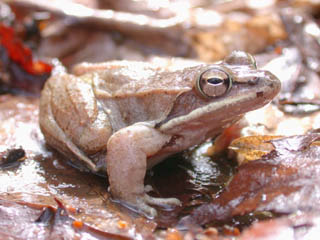Scientists closely examine causes of frog abnormalities
 Currently, research on the possible causes of limb deformities in amphibians is expansive, with evidence supporting parasite infection, chemical contaminants, UVB radiation and amputation as possible factors. However, as Mari Reeves from the U.S. Fish and Wildlife Service and colleagues explained in an article in the August issue of Ecological Monographs, the most likely cause of amphibian abnormalities is a combination of several stressors.
Currently, research on the possible causes of limb deformities in amphibians is expansive, with evidence supporting parasite infection, chemical contaminants, UVB radiation and amputation as possible factors. However, as Mari Reeves from the U.S. Fish and Wildlife Service and colleagues explained in an article in the August issue of Ecological Monographs, the most likely cause of amphibian abnormalities is a combination of several stressors.
Reeves and colleagues assessed the wood frog Rana sylvatica from 21 wetland sites in the Kenai National Wildlife Refuge (KNWR) in south-central Alaska between 2004 and 2006. According to the study, this area was chosen because it contained multiple conditions known to cause frog abnormalities:
Oil drilling and other road-associated human activities have facilitated land and water contamination by petroleum products…Historically, persistent organochlorine pesticides and herbicides have also been used. Toxic metals occur naturally at high levels in some areas, and metals and hydrocarbons may run off of roads into adjacent aquatic habitats. Global climate change is evident in south-central Alaska, where recent warmer and drier conditions have been associated with shrinking and drying of the KNWR wetlands that comprise frog breeding habitat.
From the sites, Reeves and colleagues identified metamorphs, frogs transforming from tadpoles to adults, with more than 20 types of abnormalities. Seventy-two percent of the abnormalities were skeletal and 28 percent involved the eye; specifically, deformities ranged from missing limbs to unpigmented irises.
After a series of follow-up experiments in which the researchers isolated various factors, they determined that skeletal abnormalities were related to not just one, but multiple stressors: toxic metals and organic contaminants, and even an increase in dragonfly predators due to warmer temperatures. As the authors explained:
The best predictors of skeletal abnormalities in the KNWR were early-season abundance of dragonfly larvae, metals and organic contaminants….Nevertheless, our controlled experiments showed that, although sediment and water from other KNWR study sites were toxic to developing wood frogs, exposure of tadpoles to these media during development did not directly produce asymmetrical limb abnormalities in the laboratory or in the predator exclusion experiment.
In other words, the abnormalities could not be attributed to the toxins exclusively; instead, said the researchers, it was likely a series of impacts. For example, some metals may inhibit the ability of tadpoles to detect and avoid dragonfly predators—the change in water chemistry has been shown to affect fish in similar ways. DDT, one of the pesticides tied to frog abnormalities in the KNWR, is a persistent organochlorine pesticide used historically for mosquito control; at high concentrations, DDT has been shown to alter tadpole swimming behavior, making it more vulnerable to amputation from dragonfly predators.
The researchers also observed that smaller frogs were more likely to have skeletal abnormalities—suggesting that toxins could render frogs small and weak, also hindering their ability to escape predators. Therefore, the combination of toxins, metals and predation, said the researchers, could create the conditions needed to cause limb deformities in frogs.
Reeves, M., Jensen, P., Dolph, C., Holyoak, M., & Trust, K. (2010). Multiple stressors and the cause of amphibian abnormalities Ecological Monographs, 80 (3), 423-440 DOI: 10.1890/09-0879.1